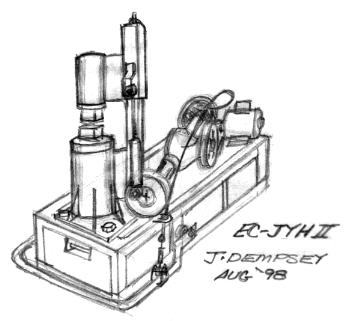| anvilfire! Power hammer Page 10 Page 1 EC-JYH Supplement Page 11 Bow Springs | |
East Coast Junk Yard Hammer Idea Sketch II
| |
|
EC-JYH-II Design Sketch (not built)
I've described the concrete filled foundation of this design several times on the Guru page and thought it was time I got this sketch posted. This design was inspired by queries from a fellow I had a long off-line discussion about putting the axle down low so it was easier to build and not so top heavy. His questions were, "Can the axle be put below the anvil and will the shock linkage work this way?" I had to think about it for a while but YES the shock linkage works exactly the same. I combined this idea with the concrete base idea I had been playing with. Please note that the concrete adds a LOT of mass to this machine but does not replace the anvil! Reasons for the concrete base:
Preliminary Specifications:
Further Comments: This is another machine that should be buildable on a $200 budget or less. The drive is set at an angle so that it fits in the smallest possible rectangle. The base as shown is rectangular but could be any polygon or even ovoid. The anvil may need to be set down into the base depending on the diameter material available but the support should be at the top for strength and load distribution. The guide system will probably be two pieces of angle with 45° flanges so that it can be easily adjusted to the tubular guide. This is actually easier than finding telescoping tubing or fabricating a box section to fit. |
|
|
Page 10
|
|